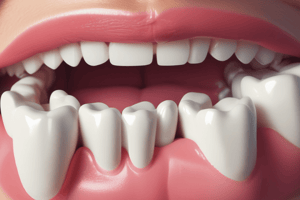Podcast
Questions and Answers
What is the primary purpose of etching in the bonding process?
What is the primary purpose of etching in the bonding process?
- To apply adhesive more effectively
- To increase surface reactivity by demineralizing (correct)
- To remove organic debris
- To dissolve calcium ions
Which concentration of phosphoric acid is recommended for etch-and-rinse adhesives?
Which concentration of phosphoric acid is recommended for etch-and-rinse adhesives?
- 20% to 30%
- 30% to 40% (correct)
- 40% to 50%
- 10% to 20%
What is the main goal of enamel etching?
What is the main goal of enamel etching?
- Removing superficial calcium layers
- Transforming enamel into a hydrophobic surface
- Increasing surface area for bonding (correct)
- Increasing the enamel's gloss
What is the effect of high viscosity and surface tension of bonding agents on etched enamel?
What is the effect of high viscosity and surface tension of bonding agents on etched enamel?
Which factor is NOT a consequence of over-etching enamel?
Which factor is NOT a consequence of over-etching enamel?
Why is gel preferred over liquid for acid etchant application?
Why is gel preferred over liquid for acid etchant application?
What is the minimum etching time recommended for enamel etching?
What is the minimum etching time recommended for enamel etching?
Which process is involved in creating microporosities in enamel during etching?
Which process is involved in creating microporosities in enamel during etching?
What can result from dead space formed due to high viscosity bonding agents?
What can result from dead space formed due to high viscosity bonding agents?
What aspect of enamel etching improves wetting for bonding agents?
What aspect of enamel etching improves wetting for bonding agents?
Flashcards are hidden until you start studying
Study Notes
Dentin Bonding
- Dentin bonding is more difficult and less reliable than enamel bonding due to differences in morphology, histology, and composition
- Dentin has more organic matter and water than enamel, making it challenging to bond
- Hydroxyapatite crystals in dentin are randomly arranged in an organic matrix, unlike enamel's regular pattern
- Fluid in dentinal tubules constantly flows outward from the pulp, reducing the adhesion of composite resin
- Smear layer presence makes wetting the dentin by the adhesive more difficult
Self-Etch Adhesives
- Do not use a separate etching step
- Two types: two-step (acidic primer and adhesive applied individually) and all-in-one adhesive (primer and adhesive in one bottle)
- Classified according to their aggressiveness or acidity: ultramild (pH > 2.4), mild (pH ≥ 2), intermediate (pH = 1.5), strong (pH ≤ 1)
Hybrid Layer
- Formed by demineralization of dentin, infiltration of monomer, and subsequent polymerization
- Responsible for micromechanical bonding between tooth and resin
- Consists of three zones: top (loosely arranged collagen fibrils and interfibrillar spaces filled with resin), middle (hydroxyapatite crystals replaced by resin monomer), and bottom (almost unaffected dentin with a partly demineralized zone)
- Primarily organic in nature, resistant to acids and proteolysis, and more elastic than dentin
- Acts as an elastic buffering layer, absorbing resin composite polymerization shrinkage stress
Adhesive Resin
- Solvent-free, filled or unfilled solution containing mainly hydrophobic monomers
- Co-polymerizes with previously applied primer and subsequently applied composite resin
- Ideal requirements: optimal bond strength, biocompatibility, long-term stability, high bond strength early, and ease of application
Enamel Bonding
- Etching creates microporosities in the interprismatic substance and in the enamel prism core
- Goals: removing organic pellicle, removing smear layer in cut enamel, and dissolving mineral crystals to make an irregular surface with numerous microporosities
- Increases surface area for bonding, surface energy, and wetting
Etch-and-Rinse Adhesives
- Use a separate etching step for enamel and dentin
- Use 30% to 40% phosphoric acid concentration
- Etching time: minimum 15 seconds
- Acid etchant supplied in a liquid or gel, with gel being preferred for easier application
Factors Affecting Enamel Etching
- Form of acid used (gel or liquid)
- Concentration of acid used
- Time of etching
- Type of acid used
- Chemical nature of enamel
- Whether enamel is fluoridated or demineralized
- Type of dentition (primary or permanent)
Permeability of Dentin
- Variation in permeability affects the bonding mechanism
- Two types of permeability: intratubular (movement of fluid within the tubules) and intertubular (diffusion of monomer into demineralized intertubular dentin)
Smear Layer
- Formed on the surface of dentin after cutting with manual and rotary instrumentation
- Composition: cutting debris, hydroxyapatite crystals, collagen, saliva, and blood
- Incorporates microorganisms
- Provides a barrier to bacterial penetration and minimizes post-operative hypersensitivity
- Controversies surrounding removal or retention of the smear layer
Studying That Suits You
Use AI to generate personalized quizzes and flashcards to suit your learning preferences.




